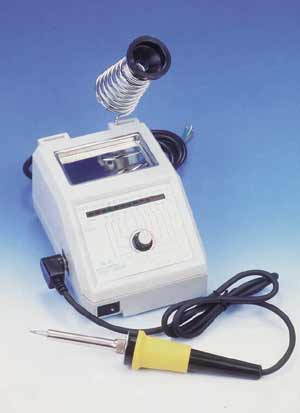Soldering Station
A good quality soldering station is a must for the advanced arcader. This model is a UNION BP 53 from Maplins UK:

It has a temperature control enabling the user to change the tip temperature from 300°F (150°C) to 790°F (420°C) without the need to change the tip or heating element. It’s a fantastic unit, which is really good for desoldering as the temperature goes up quite high. This is obviously important because to repair boards we often need to remove faulty IC’s using the following tools:
- Desoldering Pump
- Desoldering Braid
- Needle Nose Pliers
- IC Cutters/ PRO Micro Nippers (!)
When using desoldering braid be extra careful not to leave small wire strands on the solder joints. This happens as the braid works by holding it against the solder you wish to remove and heating it with the soldering iron. The solder always moves towards the heat source and is therefore ‘soaked’ up by the braid. Of course, sometimes the braid gets attached to the board by the solder and the temptation is to give it a little tug, but this often leaves behind those strands of braid wire which can lead to short circuits.
The best way to remove a component which you are sure is faulty is to snip all of its legs at the very top using cutters. Then heat each leg from under the board and pull them out individually using needle nose pliers. When they are all out, heat each hole with the soldering iron and clear the stray solder by using the pump on the opposite side. You can buy a desoldering station, which is like a normal soldering station but the tip is hollow and allows you to suck while heating. A handy tool, but an expensive one too…
When a faulty component is removed successfully its always a good idea to
insert a DIL socket instead of just putting a replacement back onto the board.
This ensures that should that component become faulty again for whatever
reason, it will be easily replacable.
Another good tip here is to keep the snipped legs! Often you will receive a board which has IC’s with extremely brittle legs, if not already broken they do tend to break when removed from their sockets. It is possible to repair them by carefully soldering on the extra legs you have spare! Note… An IC with brittle legs often means it has been creating a lot of heat, which is also a sign of being faulty.